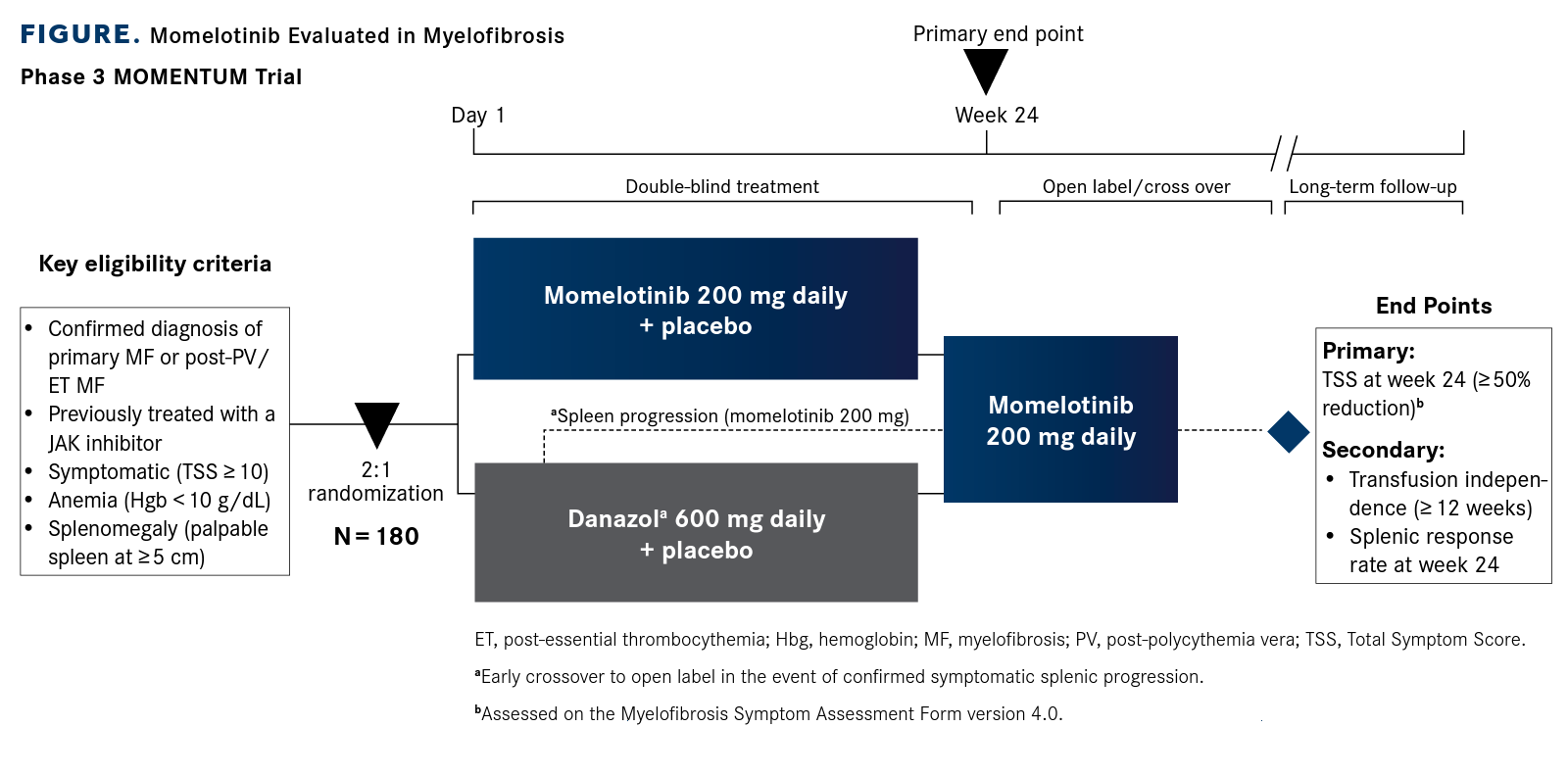Momelotinib Trial Seeks to Address Myelofibrosis Symptoms
January 6, 2021 - The MOMENTUM trial will randomize patients to receive momelotinib or danazol to determine which regimen shows more efficacy against the MF hallmarks of anemia, constitutional symptoms, and splenomegaly.
Ruben Mesa, MD

Momelotinib, an orally administered novel agent, is being evaluated in a phase 3 trial in patients with symptomatic and anemic myelofibrosis (MF), a population that experts say is in need of new options. The MOMENTUM trial (NCT04173494) will randomize patients who have previously received a JAK inhibitor to receive momelotinib or danazol to determine which regimen shows more efficacy against the MF hallmarks of anemia, constitutional symptoms, and splenomegaly.1
Momelotinib is a small-molecule inhibitor of the Janus kinases 1 and 2 (JAK1/2) and activin A receptor type-I (ACVR1).1 Danazol, a synthetic steroid that the FDA has approved for patients with endometriosis and hereditary angioedema, is included in National Comprehensive Cancer Network guidelines as a treatment for anemia in patients with MF with serum erythropoietin levels greater than 500 mU/mL.2,3
Current therapies available to treat patients with MF such as ruxolitinib (Jakafi) and fedratinib (Inrebic) may not help address the anemia that patients often experience, and they may even aggravate it, said Ruben Mesa, MD, executive director of The University of Texas San Antonio MD Anderson Cancer Center.
“Both ruxolitinib and fedratinib are approved JAK inhibitors in myelofibrosis,” Mesa, a chief coinvestigator on the MOMENTUM study, said in an interview with OncologyLive®. “They are both very good drugs. They both help with splenomegaly and symptoms. They really have made an important impact on the disease, but they don’t help with anemia.”
Momelotinib’s anemia benefit is primarily achieved through direct inhibition of the kinase ACVR1, a member of the transforming growth factor β receptor family that influences production of hepcidin, an iron regulatory hormone. Hepcidin is often elevated in patients with MF, resulting in reduction of iron availability and restriction of erythropoiesis.4
“It’s thought that an additional contributor to the anemia in myelofibrosis is hepcidin and that an inflammatory environment might be suppressing hematopoiesis. By alleviating that, there can be an improvement in erythropoiesis and a decrease in anemia,” Mesa said.
Momentum Focuses on Symptoms
In the MOMENTUM trial, patients are being randomized 2:1 to momelotinib plus placebo or danazol plus placebo. At the end of week 24, patients randomized to momelotinib can continue on treatment up to approximately 4 years. Patients who received danazol may cross over to momelotinib or continue to receive danazol (FIGURE).
Mesa said the choice of a comparative therapy for the study was challenging. “Danazol is one of the most widely available agents that has some activity for anemia. It is a relatively well-tolerated drug with response rates of 20% to 30%. We think this was the strongest control arm that could be offered. It highlights why there is such significant unmet need for these patients.” The primary end point will be Total Symptom Score (TSS) response rate using the Myelofibrosis Symptom Assessment Form version 4.0, with the response rate defined as the proportion of patients who achieve a reduction of 50% or more over the 28 days before the end of week 24 of therapy. Key secondary end points will include transfusion independence (TI) and splenic response rate (SRR) at 24 weeks. TI is defined as not requiring red blood cell (RBC) transfusion for 12 weeks or longer and splenic response is defined as a reduction in spleen volume of 35% or more from baseline with hemoglobin level ≥ 8 g/dL.
“This trial puts symptoms of myelofibrosis front and center as one of the primary end points,” Mesa said. “We’re trying to make an impact on the patient’s overall quality of life, and we are hopeful about this trial in terms of the overt symptoms that patients face. I envision it will impact their quality of life both in terms of symptoms but also in terms of the burden of being transfusion dependent. We recognized that being transfusion dependent is a tremendous burden on our patients.”
Investigators aim to recruit 180 patients through more than 150 sites in the United States and other countries. Sierra Oncology, which is developing the therapy, expects enrollment to be completed by the middle of 2021 and top-line data to be reported in the first half of 2022.5
FIGURE. Momelotinib Evaluated in Myelofibrosis

Early Findings Vary
Clinical development of momelotinib in MF has been under way for more than 7 years, and more than 800 patients with the malignancy have received the drug in several settings.6 Sierra Oncology has provided access to momelotinib for patients with primary MF, post–polycythemia vera MF, or post–essential thrombocythemia MF who participated in prior studies.7 Of the 137 patients who have enrolled in the extended-access protocol, 105 remain on momelotinib therapy including some who have taken the drug for up to 10 years.6
In the phase 3 SIMPLIFY-1 trial (NCT01969838), momelotinib was compared with ruxolitinib in 432 patients who had not received prior JAK inhibitor therapy and who had MF classified as high- or intermediate-2 risk or symptomatic intermediate-1 risk on the International Prognostic Scoring System.8
Primary findings showed that momelotinib met the statistical threshold for noninferiority to ruxolitinib for spleen response (P = .011) but not for TSS (P = .98). Nevertheless, patients who received momelotinib had a higher rate of TI at 24 weeks than those who took ruxolitinib (65.5% vs 49.3%, respectively), a lower rate of transfusion dependence (30.2% vs 40.1%), and a lower median RBC requirement (0.0 vs 0.4 units/month).8
The phase 3 SIMPLIFY-2 trial (NCT02101268) was conducted in 156 patients with MF who had suboptimal responses or hematological toxicity during prior ruxolitinib therapy. Participants were randomized 2:1 to momelotinib at 200 mg daily or best available therapy, which could include ruxolitinib, chemotherapy, steroids, no treatment, or other standard intervention. Most patients (89%) received ruxolitinib.9
Findings showed reduction in spleen volume of 35% or more in 7% of patients who received momelotinib versus 6% in the ruxolitinib/best available therapy group, for a proportion difference of 0.01 (95% CI, 0.090.10; P = .90).9
Long-Term Updated Enhance Profile
Overall, findings from the SIMPLIFY studies show that momelotinib provides splenic responses similar to ruxolitinib while improving constitutional symptoms, reducing the RBC burden, and improving anemia, Srdan Verstovsek, MD, PhD, said during a presentation at the 62nd American Society of Hematology Annual Meeting and Exposition in December (ASH 2020).6
“Momelotinib is the only JAK inhibitor [that] may be able to provide benefit for each of the 3 main features of myelof ibrosis,” said Verstovsek, who is director of the Hanns A. Pielenz Clinical Research Center for Myeloproliferative Neoplasms at The University of Texas MD Anderson Cancer Center in Houston. “Importantly, momelotinib accomplishes this while demonstrating a favorable safety profile, which includes relatively low rates of grade 3 thrombocytopenia and anemia.”
Verstovsek and colleagues retrospectively examined long-term outcomes for participants in the SIMPLIFY-1 and SIMPLIFY-2 trials as well as the extended-access protocol. They concluded that momelotinib delivered durable benefits.
For patients treated during SIMPLIFY-1, the median overall survival (OS) after follow-up of nearly 5 years was 53.1 months for those who received ruxolitinib in the f irst line and then crossed over to momelotinib after 24 weeks, but it was not reached among patients originally treated with momelotinib (HR, 0.99; P = .97).
Among SIMPLIFY-2 participants, the median OS for patients treated first with ruxolitinib or best available therapy who then crossed over to momelotinib was37.5 months compared with 34.3 months for those originally randomized to receive momelotinib (HR, 0.96; P = .86). The momelotinib findings compare favorably with previously reported median OS ranging from 13 to 30 months in patients who have discontinued ruxolitinib, investigators said.
In terms of splenic response, 27% of patients in the momelotinib group and 29% in the ruxolitinib cohort in SIMPLIFY-1 achieved a reduction in spleen volume of 35% or more by week 24 (noninferiority P < .001). Overall, 40% of patients randomized to momelotinib achieved a splenic response at any time during the study.
In both trials, the proportion of patients able to achieve TI at week 24 for momelotinib compared with ruxolitinib or best available therapy, respectively, was 67% versus 49% (P = .001) in SIMPLIFY-1 and 43% versus 21% (P = .001) in SIMPLIFY-2.
Investigators also examined symptom-related outcomes for patients in the thrombocytopenia and intention-to-treat populations in the SIMPLIFY trials in a separate retrospective analysis also presented at ASH 2020.10
In SIMPLIFY-1, the TSS response rate with momelotinib versus ruxolitinib, respectively, was 28% versus 33% for those with a baseline platelet count of less than 150 x 109/L and 28% versus 41% for the overall population. In SIMPLIFY-2, the TSS rates were higher across platelet levels for momelotinib versus ruxolitinib: 24% versus 3%, respectively, for those with platelet counts of 150 x 109/L or lower, and 26% versus 6% overall.
Moreover, the rates of treatment-emergent adverse effects with momelotinib therapy were similar among patients with platelet levels lower than 150 x 109/L and in the overall populations in both studies, although nausea, fatigue, and anemia were more common in those with lower platelet levels.
“These analyses demonstrate that momelotinib safety and activity profile do not appear to be affected by baseline platelet count,” Jean-Jacques Kiladjian, MD, PhD, head of the Clinical Investigation Center at Saint Louis Hospital in Paris, France, said while presenting the data. “In contrast, activity with ruxolitinib declined in patients with lower platelets.”
References
- A study of momelotinib versus danazol in symptomatic and anemic myelofibrosis patients (MOMENTUM). ClinicalTrials.gov. Updated December 7, 2020. Accessed December 10, 2020. https://clinicaltrials.gov/ct2/show/NCT04173494
- Danazol capsule. DailyMed National Library of Medicine. Accessed December 10, 2020. https://bit.ly/373f61r
- NCCN. Clinical Practice Guidelines in Oncology. Myeloproliferative neoplasms, version 1. 2020. Accessed December 10, 2020. https://www.nccn.org/professionals/physician_gls/pdf/mpn.pdf
- Oh ST, Talpaz M, Gerds AT, et al. ACVR1/JAK1/JAK2 inhibitor momelotinib reverses transfusion dependency and suppresses hepcidin in myelofibrosis phase 2 trial. Blood Adv. 2020;4(18):4282-4291. doi:10.1182/bloodadvances.2020002662
- Sierra Oncology reports third quarter 2020 results. News release. Sierra Oncology; November 5, 2020. Access December 3, 2020. https://bit.ly/3mC2wLZ
- Verstovsek S, Egyed M, Lech-Maranda E, et al. Robust overall survival and sustained efficacy outcomes during long term exposure to momelotinib in JAK inhibitor naïve and previously JAK inhibitor treated intermediate/high risk myelofibrosis patients. Presented at: 62nd American Society of Hematology Annual Meeting and Exposition, December 5-8, 2020. Abstract 54. https://bit.ly/3g7WsIS
- Extended access of momelotinib in adults with myelofibrosis. ClinicalTrials.gov. Updated February 26, 2020. Accessed December 3, 2020. https://bit.ly/3okADbW
- Mesa RA, Kiladjian JJ, Catalano JV, et al. SIMPLIFY-1: a phase III randomized trial of momelotinib versus ruxolitinib in Janus kinase inhibitor–naïve patients with myelofibrosis. J Clin Oncol. 2017;35(34):3844-3850. doi:10.1200/JCO.2017.73.4418
- Harrison CN, Vannucchi AM, Platzbecker U, et al. Momelotinib versus best available therapy in patients with myelofibrosis previously treated with ruxolitinib (SIMPLIFY 2): a randomised, open-label, phase 3 trial. Lancet Haematol. 2018;5(2):e73-e81. doi:10.1016/S2352-3026(17)30237-5
- Kiladjian JJ, Platzbecker U, Mayer J, et al. Momelotinib’s spleen, symptom and anemia is maintained in intermediate/high risk myelofibrosis patients with thrombocytopenia. Presented at: 62nd American Society of Hematology Annual Meeting and Exposition, December 5-8, 2020. Abstract 3086. https://bit.ly/33F8T9W




